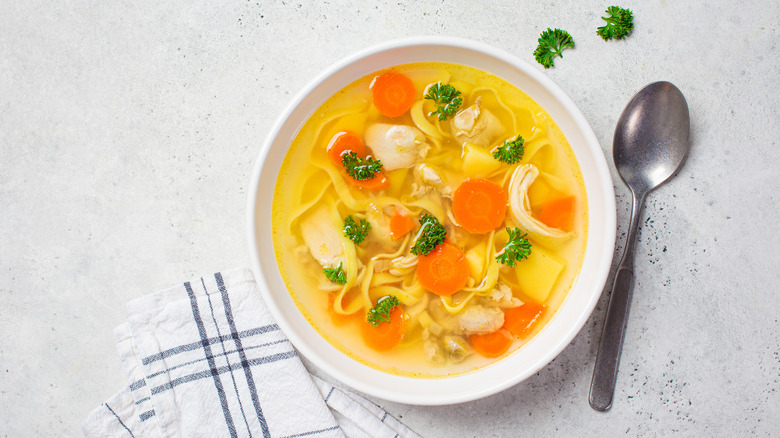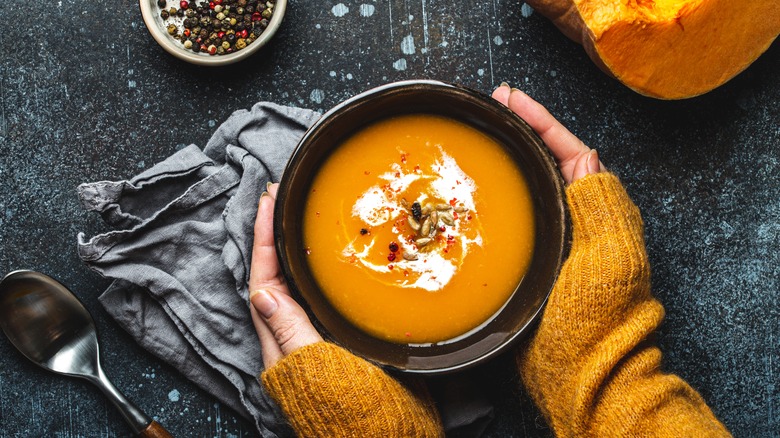Why Reduced-Sodium Canned Soups Still Often Contain High Levels Of Salt
It's not uncommon to add a little salt to your dinner, but you might be surprised how much sodium is already inside commonly consumed products, like canned soup. According to the Dietary Guidelines for Americans, the average adult should only consume 2,300 milligrams of sodium daily. That may sound like a lot — but it's equivalent to only one teaspoonful of salt! The majority of Americans actually consume way more than that: an average of 3,400 milligrams per day (via U.S. Food and Drug Administration).
For many people, sources of sodium in our diet extend far beyond kosher, table, and sea salt. Salt is a compound, whereas sodium is one chemical component within salt as well as many other things we consume: The Centers for Disease Control and Prevention lists the top 10 things that contribute to sodium in the diets of most Americans, and the biggest contenders are pizza, cured meats, and soups.
In the past, sodium was added to foods in heavy amounts for preservation, according to "Strategies to Reduce Sodium Intake in the United States." Salt was a very useful way of keeping things from going bad. But now that equipment like refrigerators and dehydrators are widely accessible, why would our food still have so much salt? It turns out, there are a couple of reasons your food products — even those labeled as reduced sodium — may still contain high levels of sodium.
Why sodium is so prevalent in canned soups
First, sodium still helps increase the shelf-life of a product, according to "Strategies to Reduce Sodium Intake in the United States." In a world where many processed foods are shipped across the country — or even the world — making sure that foods are shelf-stable is a priority. Salt can hold the development or growth of threatening pathogens at bay. It helps to minimize the water activity within foods by pulling some of the water out to the surface of a food item, according to Scientific American. This helps prevent microbial growth that could make you sick.
Second, salt makes a big difference in the taste and texture departments. At this point, people may just be accustomed to the taste of high sodium levels, even if they aren't actively trying to buy food with high sodium levels (via the Food and Agriculture Organization of the United Nations). Soups often include naturally high-sodium ingredients like cheese or certain types of meat. As a result, it's not uncommon to find canned soups that contain 1,200 to 1,400 milligrams of sodium! That's over half of the recommended daily intake. Fortunately, if you are aware of what sodium levels are acceptable in your diet and diligent about reading labels, you can find soups that actually are low in sodium.
What does low sodium actually mean?
For something to be considered "low sodium," it needs to contain 140 milligrams of sodium or less per serving (via Pacific Source). This is a lot less than the recommended daily limit — but don't be fooled by labels that say "reduced sodium." Reduced sodium is not the same thing as low sodium. Low sodium is a predetermined amount of sodium, whereas reduced sodium is a relative term — and therefore can still be quite high. According to Pacific Source, reduced sodium generally means that one serving of the soup or other food item in question has 25% less sodium than the item normally would.
The best way to figure out how much sodium is truly in your canned soup is to look at the label. You should always read the label on products you buy to know what is really in them. Canned soup is one of those products that, while delicious, can pack a lot of sodium without it being obvious. While certain soups may appear to be lower in sodium, the only way to know for sure is to read the label yourself! This enables you to make the best choice possible when choosing canned foods for yourself and your family.


